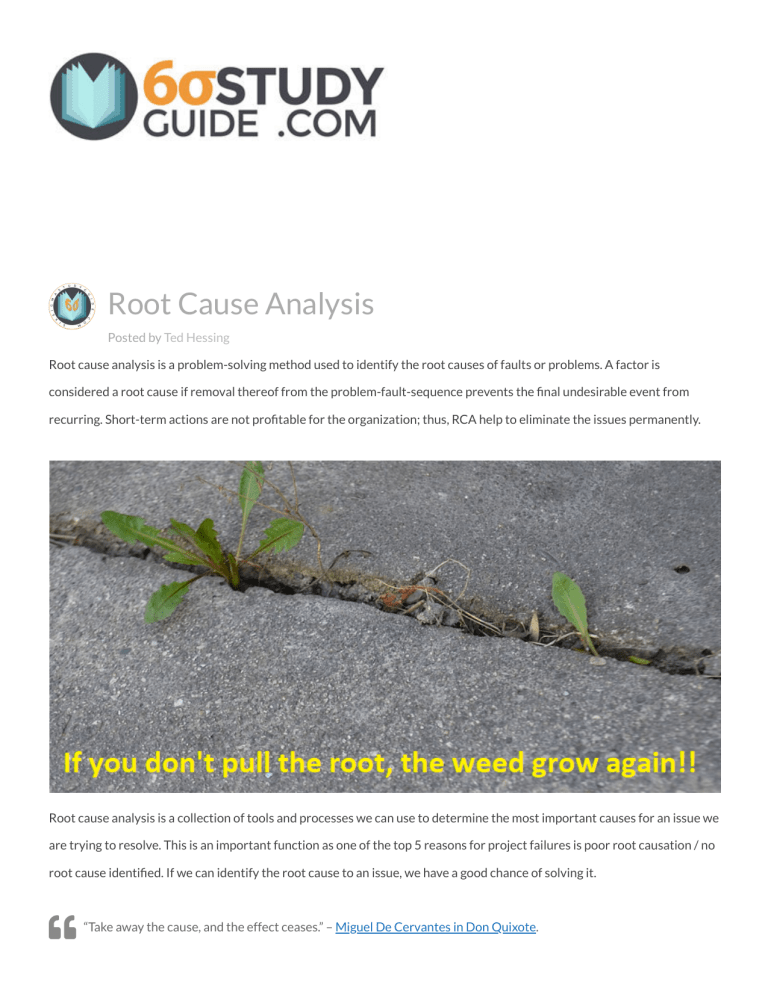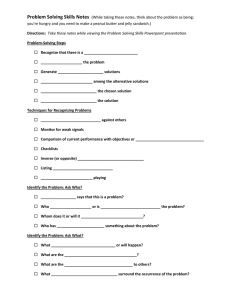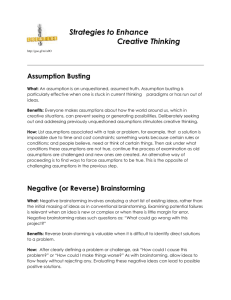
Root Cause Analysis Posted by Ted Hessing Root cause analysis is a problem-solving method used to identify the root causes of faults or problems. A factor is considered a root cause if removal thereof from the problem-fault-sequence prevents the final undesirable event from recurring. Short-term actions are not profitable for the organization; thus, RCA help to eliminate the issues permanently. Root cause analysis is a collection of tools and processes we can use to determine the most important causes for an issue we are trying to resolve. This is an important function as one of the top 5 reasons for project failures is poor root causation / no root cause identified. If we can identify the root cause to an issue, we have a good chance of solving it. “Take away the cause, and the effect ceases.” – Miguel De Cervantes in Don Quixote. Why Root Cause Analysis? In a process, unpredicted problems may occur at any time, which leads to machine downtime, rework, rejections, or customer dissatisfaction. Fixing a process is quickly becomes a convenient solution. However, it does not prevent the problem’s re-emergence. Hence, teams to focus on finding the root cause using appropriate tools to develop a more effective strategy to overcome it. When should conduct Root Cause Analysis RCA process involves data collection, analysis, root cause identification, initiate corrective actions, and implementation. Root cause analysis is performed to determine what happened, why the issue has happened, and what action to implement to reduce or eliminate it. RCA is used to identify issues in the process, analyze customer complaints, reasons for high rework, machine downtime, etc. Moreover, It helps to identify target opportunities for systemwide improvement. Basics of Root Cause Analysis Before diving in with the aforementioned tools, it’s good to start with Causal Theory. In other words, Why does a certain problem exists? To do this we start with a basic equation; Y = f(x) ; Y is the Output of a process. X are the Process elements that influence Y Another way to state this is Y is the crime ; X’s are the suspects that explain the crime of Y Data door & Process door Some of my instructors refer to the data door and the process door. Both are good to get to root causation but certain tools are better in certain circumstances. Effectiveness project – use data door. Efficiency project – use process door. Root Cause Analysis: Open-Narrow-Close To validate root causes identified in the Open-Narrow-Close efforts, the team should employ three tools/techniques: Basic data collection: In the DMAIC methodology, a data collection plan is created during the Measure phase. It is a useful tool to focus your data collection efforts on. Scatter Analysis/Regression: Linear regression is a statistical technique to estimate the mathematical relationship between a dependent variable and an independent variable . In other words, predict the change in the dependent variable according to the change in the independent variable. Design of Experiments.: The objective of Design of Experiments (DOE) is to Establish optimal process performance by finding the right settings for key process input variables. Furthermore, Design of Experiments is a way to intelligently form frameworks to decide which course of action you might take. This is helpful when you are trying to sort out what factors impact a process. Open phase In the open phase you want to gather as many ideas as possible. To do that first you use the Brainstorming. It is a method for generating a large number of creative ideas in a short period of time. Brainstorming creating a large list of ideas which may eventually be boiled down, or funneled down, to a smaller list of priority items later in the project. Team then try to pairing with Fishbone or Cause and Effect Diagram. It is the one of the seven basic quality tools which identifies many possible cause for an effect or problem. Fishbone diagram can be used to structure a brainstorming session. It sorts ideas into useful categories. Narrow Phase After brainstorming , Fishbone or Cause and Effect Diagram or some other expansion tool has been used to generate a long list of possibilities. Then decision must be made by group judgment to narrow down the list. Multivoting is a way for a group to narrow down a list of choices down to a manageable few. While multivoting is NOT a decision making tool, it is a great way to achieve consensus on an option that is most-favored by the group. Close Phase Once the agreed actions are implementing, team to close the process by validate using Hypothesis and convict them or set them free. Validated X’s will be worked on to IMPROVE phase. Types of Root Cause Analysis Tools Root cause analysis (RCA) can be performed using a variety of statistical tools. However, there is no fixed rule existed to apply the certain tool. Hence, subject matter experts like Quality team or six sigma champion determine the appropriate tool based on the scenario. Brainstorming: Brainstorming is a method for generating a large number of creative ideas in a short period of time. Brainstorming is full of energy, moves rapidly, and is synergistic, creating a large list of ideas which may eventually be convert it to a smaller list of priority items later in the project. Fishbone Diagram: A Cause and Effect Diagram (aka Ishikawa, Fishbone) is a pictorial diagram showing possible causes (process inputs) for a given effect (process outputs). In other words, it is a visual representation to find out the cause(s) of a specific problem. 5 Whys: The 5 Whys is a basic root cause analysis technique to solve a problem, we need to identify the root cause and then eliminating it. The 5 Why method is simply asking the question “Why” enough times until to past all the symptoms of a problem and down to the root cause ( not just till 5 whys). Pareto and data analysis: The Pareto Chart is a graphical tool to map and grade business process problems from the most recurrent to the least frequent. In other words, this helps to identify the most frequently occurring problems or separate the vital few from the trivial many. FMEA: Failure Mode Effects Analysis (FMEA) is a tool that helps us anticipate what might go wrong with a product or process. We can also use it to identify the possible causes and probabilities of failures. Steps to perform Root Cause Analysis Form a small team (consists of members from process area, subject matter expert, Quality team) to perform root cause analysis Define the problem and describe it in clear and comprehensive language. Collect the data and create a timeline to visualize the sequence of events that occurred Differentiate causal factors or symptoms and the root cause of the problem. Use appropriate tools such as 5Why, Fishbone to systematically identify the root cause of the problem. Prioritize the root cause that needs to be addressed first, which has a high impact on the process Implement appropriate corrective action(s) to prevent the recurrence of the same issue in the future. Monitor the progress and communicate with relevant stakeholders Root Cause Example in DMAIC Project Example 1: A female operator from XYZ organization fell in the assembly area and was injured during the second shift. Perform the root cause analysis to avoid the recurrence of the issue. Example 2: XYZ organization reported most the service complaints are due to inaccurate seal diameter (out of specification). Benefits Root cause analysis helps to define the problem and identify the root cause(s) of the problem. Help to identify improvement opportunities in the organization. Provides confidence to the customers that organizations are valuing the feedback and analyzing systematically to identify root causes Root cause analysis helps to implement mistake-proofing solutions It helps to implement preventive actions across the organization. Root Cause Analysis Videos Six Sigma: Root Cause Analysis Examples IS/ISNOT - Root Cause ASQ Webcast - Get the Defects Out of Ro… Ro… Good video, awful sound. I muted it and just clicked through at a good pace. It gets the point across. Other Helpful Notes Also see Linear Regression for Y = f(x) Causal Theory=f(x) Hypothesis Testing Authors Ted Hessing I originally created SixSigmaStudyGuide.com to help me prepare for my own Black belt exams. Overtime I've grown the site to help tens of thousands of Six Sigma belt candidates prepare for their Green Belt & Black Belt exams. Go here to learn how to pass your Six Sigma exam the 1st time through! View all posts Ramana PV View all posts This entry was posted in Analyze and tagged ASQ, Black Belt, Green Belt, Villanova, Yellow Belt. Bookmark the permalink. Comments (6) Srijit c December 28, 2016 at 1:20 pm Root cause can also be calculated from 4M aka Fishbone diagram Reply Ted Hessing August 16, 2019 at 6:35 am Absolutely right, Srijit. Thank you. Reply T.BAGAVATHI April 12, 2017 at 1:41 pm For a failure there may be so many causes -but the cause or causes identified for the current failure is called the root cause . Corrective action to be taken in such a way that will not occurring again ie avoiding recurrence. Preventive action is the one what we take before the occurrence of that event ie avoiding occurrence. Reply Six Sigma Study Guide April 17, 2017 at 12:39 pm Great points, T. Thank you for contributing. Reply Fahed April 21, 2020 at 1:41 am My Question is when to initiate a root cause analysis and when to find causes through application of six sigma ? Reply Ted Hessing April 21, 2020 at 11:13 am Hi Fahed, In Six Sigma you generally follow the DMAIC paradigm – Define, Measure, Analyze, Improve, and Control. You would do root cause analysis in the Analyze phase. Does that help? Best, Ted. Reply This site uses Akismet to reduce spam. Learn how your comment data is processed.





